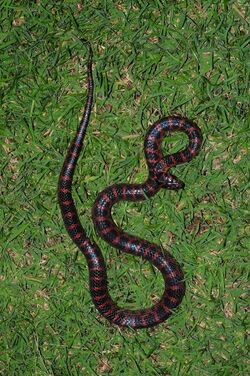Biology:Lycodon rufozonatus
| Lycodon rufozonatus | |
|---|---|

| |
| Scientific classification | |
| Domain: | Eukaryota |
| Kingdom: | Animalia |
| Phylum: | Chordata |
| Class: | Reptilia |
| Order: | Squamata |
| Suborder: | Serpentes |
| Family: | Colubridae |
| Genus: | Lycodon |
| Species: | L. rufozonatus
|
| Binomial name | |
| Lycodon rufozonatus (Cantor, 1842)
| |
| Subspecies | |
| |
| Synonyms [2] | |
| |
Lycodon rufozonatus is a species of snake in the family Colubridae. The species is native to East Asia. It is medium-sized, nocturnal, and is considered non-venomous. Two subspecies are recognised, one of which, L. r. walli, is restricted to the Ryukyu Archipelago.
Etymology
The subspecific name, walli, is in honor of British herpetologist Frank Wall.[3]
Description
Lycodon rufozonatus typically grows to a total length (including tail) of around 70 centimetres (28 in), reaching up to 130 cm (51 in) in extreme cases.[4] The head is long and relatively flat, and somewhat separate from the neck. The medium-sized eyes bulge slightly and have vertical pupils. The ventral scales have a strong keel, while the dorsal scales are only faintly keeled; the scale count is typically 17:17:15, but can be up to 21:19:17.[4]
Geographic range
Lycodon rufozonatus is found across a large part of East Asia, from the Korean Peninsula in the north (and extending just into easternmost Russia ) to northern Laos and Vietnam in the south; the bulk of its range in found in eastern China .[4] The continental populations are all placed in the nominate subspecies (L. r. rufozonatus); a second subspecies, L. r. walli, is found in the Ryukyu Archipelago of southern Japan.[5]
Behaviour and ecology
Lycodon rufozonatus lives in a wide variety of habitats; it can be found from near sea level to as high as 2,000 metres (6,600 ft), and is most common near river plains.[4] It is usually found on the ground, but is occasionally seen swimming in streams.[4] It is nocturnal, feeding on fish, frogs, lizards, snakes and young birds.[4] D. rufozonatus has a generally mild disposition, curling into a spherical mass with the head hidden when approached. Individuals can, however, be unpredictable, and some will bite readily.[4] There are very few clinical reports on the toxinology of D. rufozonatus bites, but the species appears to be non-venomous.[4] L. rufozonatus can harbour tapeworms of the genus Spirometra, and the consumption of raw meat from D. rufozonatus has led to cases of human sparganosis in Korea and Japan.[6]
Reproduction
L. rufozonatus is oviparous.[2]
Taxonomic history
The species was first described as "Lycodon rufo-zonatus " by Theodore Edward Cantor in an 1842 paper on the fauna of "Chusan" (Zhoushan, China ) in the Annals and Magazine of Natural History.[7] Cantor included it among the "innocuous" (not venomous) species, and described it as "Brown, with numerous transversal crimson bands; the abdominal surface pearl-coloured, spotted with black on the tail".[7]
Common names
L. rufozonatus is known by several common names, including "Asian king snake",[8] "banded red snake", "red banded krait", "red banded odd-toothed snake" and "red-banded snake".[4]
References
- ↑ Li, P.; Zhou, Z.; Guo, P.; Jiang, J.; Ji, X.; Borkin, L.; Milto, K.; Golynsky, E. et al. (2017). "Lycodon rufozonatus". IUCN Red List of Threatened Species 2017: e.T192124A2043244. doi:10.2305/IUCN.UK.2017-3.RLTS.T192124A2043244.en. https://www.iucnredlist.org/species/192124/2043244. Retrieved 18 November 2021.
- ↑ 2.0 2.1 Species Lycodon rufozonatus at The Reptile Database www.reptile-database.org.
- ↑ Beolens, Bo; Watkins, Michael; Grayson, Michael (2011). The Eponym Dictionary of Reptiles. Baltimore: Johns Hopkins University Press. xiii + 296 pp. ISBN:978-1-4214-0135-5. (Dinodon rufozonatus walli, p. 279).
- ↑ 4.0 4.1 4.2 4.3 4.4 4.5 4.6 4.7 4.8 "Dinodon rufozonatum". Clinical Toxinology Resources. University of Adelaide. http://www.toxinology.com/fusebox.cfm?fuseaction=main.snakes.display&id=SN1256.
- ↑ Ananjeva, Natalia B. (2006). "Red-banded snake Dinodon rufozonatus (Cantor, 1840)". The Reptiles of Northern Eurasia: Taxonomic Diversity, Distribution, Conservation Status. Series faunistica. 47. Pensoft Publishers. p. 141. ISBN 9789546422699. https://books.google.com/books?id=u4ElblE-6wgC&pg=PA141.
- ↑ Cook, Gordon Charles; Zumla, Alimuddin (2009). Manson's Tropical Diseases (22nd ed.). Elsevier Health Sciences. p. 1662. ISBN 9781416044703. https://books.google.com/books?id=CF2INI0O6l0C&pg=PA1662.
- ↑ 7.0 7.1 Cantor, Theodore Edward (1842). "General features of Chusan, with remarks on the flora and fauna of that island". Annals and Magazine of Natural History. First Series 9 (59, 60): 361–371, 481–493. doi:10.5962/bhl.title.6704. https://www.biodiversitylibrary.org/page/2312956. (Lycodon rufo-zonatus, new species, p. 483). (in English and Latin).
- ↑ Dieckmann,Simon; Norval, Gerrut; Mao, Jean-Jay (2010). "A description of an Asian king snake (Dinodon rufozonatum rufozonatum [Cantor, 1842]) clutch size from central western Taiwan". Herpetology Notes 3: 313–314. http://www.herpetologynotes.seh-herpetology.org/Volume3_PDFs/Dieckmann_et_al_Herpetology_Notes_Volume3_pages313-314.pdf. Retrieved 2012-09-17.
External links
- Stejneger, Leonhard (1907). "Herpetology of Japan and adjacent territory". United States National Museum Bulletin 58. https://archive.org/details/herpetologyjapa00stejgoog. Includes description of D. r. walli
- "Dinodon rufozonatum ". http://www.snakesoftaiwan.com/Dinodon%20rufozonatum/species_dinodon_rufozonatum.htm. Snakes of Taiwan.
Wikidata ☰ Q1152359 entry
 |


